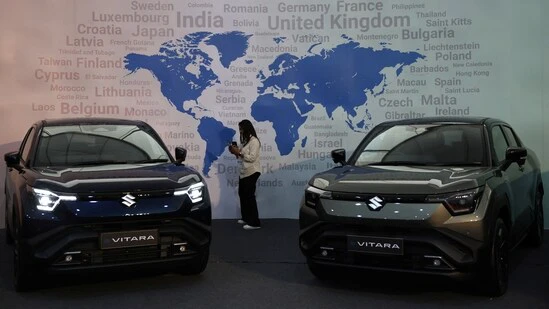The Prime Minister of India flagging off of the first Suzuki e-Vitara to roll off the production line, marks a landmark moment for the country’s EV manufacturing prowess.
The first unit of the e-Vitara will be exported to the UK, one of 100 countries which the e-Vitara will be shipped to from the Suzuki Motor Plant in Hansalpur, Gujarat.
Ever since the e-Vitara was unveiled at the Bharat Mobility Global Expo 2025 in New Delhi, India has served as ground zero for Suzuki’s global BEV aspirations. Often questioned for its late entry into the EV market, Suzuki Motor Corp. has nonetheless shown sound strategy by creating a born-electric platform that was-right from the start-designed and engineered for markets beyond domestic ones, including highly competitive ones such as Japan and Europe.
At a time when local market leaders like Tata Motors Ltd. and Mahindra & Mahindra Ltd.’s plans to export their electric cars to markets like UK and Europe are still in development, Suzuki’s announcement comes as a huge show of faith in India’s EV manufacturing prowess. Particularly when you consider the fact that Tata Motors export markets are currently limited to Sri Lanka, Nepal and Mauritius, with South Africa has been added to the list, after a six-year hiatus. So what sets the e-Vitara apart?
A born-electric platform with multi-brand potential
The platform underpinning the e-Vitara has been jointly developed by Suzuki, Toyota Motor Corp. and Daihatsu, with Suzuki leading its development, as reported by Reuters in 2024. Essentially, the BEV’s skateboard architecture, e-axle and battery integration are the result of a tri-party collaboration, while the rest of the vehicle including its design, electronics, features, etc., have all been developed by Suzuki. It’s this tri-party venture that lends the e-Vitara its export worthiness, while the plant gives it the sort of scalability that even domestic market leaders like Tata Motors and Mahindra do not possess.
The Suzuki e-Vitara will be sold in two primary configurations, with 49 kWh and 61 kWh battery packs, front-wheel drive and AWD configurations (Suzuki’s proprietary AllGrip technology). It will also be rebadged as Toyota’s Urban Cruiser EV, once again, featuring Suzuki’s Heartect-e platform. The platform itself has been derived from Suzuki’s existing lightweight Heartect platform, which has been adapted into a skateboard layout with battery integration.
However, the global homologation of the product required Toyota-the world’s largest car maker by sales-to flex its muscles and ensure that the platform meets EuroNCAP, ASEAN NCAP and stringent Japanese crash standards, which in turn gave the car its export viability. Toyota also leveraged its work on LFP safety protocols to help develop the battery management system.
Home-grown battery electrodes; imported battery
The
also points out the significance of the Hansalpur plant’s battery manufacturing capabilities, with the PM calling the production of hybrid battery electrodes “a big boost to our battery ecosystem”.
It’s important to highlight the distinction that while the Suzuki e-Vitara is heavily localised, including the local manufacturing of the battery electrode, the electric SUV will continue to use imported battery cell packs, specifically those pioneered by Chinese EV giant BYD, famous for its cutting-edge “Blade” variety of Lithium-ion Phosphate batteries.
However, the manufacturing of electrodes by a mass market manufacturer is a major step towards supply chain independence.
According to Epsilon Advanced Materials MD Vikram Handa, the local manufacturing of the electrode-the positive (cathode) and negative (anode) layers that store and release lithium ions during charging and discharging-“will definitely give a boost to the EV segment”.
“But the next question is, are they buying the anode and cathode from India? Previously battery makers were buying a coated foil from China and just putting powder on the foil in India. In my opinion, for the supply chain to really develop, it’s important that the powder be made in India, as well as the foil,” Handa says.
Handa attests that as with much of the EV supply chain, the electrode in its entirety has thus far been sourced from China. Cautioning against an overreliance on China, Handa once again underscores the importance of locally manufacturing the battery electrode.
“The problem is that China has excess capacity and is really cheap so customers are going to China. But the issue is that in the supply chain, there’s a lot of stickiness. Say, they are buying a product at $5 and I’m selling it $6, naturally they don’t want to buy it from me,” says Handa, whose company specialises in manufacturing anodes and cathodes for battery makers with the plan of setting-up a 2,000-tonne anode and cathode plant in India.
“But the issue is that even two years later, if the Chinese product has gone to $8 and I’m at $5, they can’t buy it from me because you cannot change the supply chain during the lifecycle of a particular model of car or scooter. For about six years, you’re locked-in.”
| From Maruti 800 to e-Vitara, Suzuki’s ₹70,000-crore India plan signals continuity
The manufacturing of a localised electrode increases the possibility of battery makers sourcing anodes and cathodes locally, and while the country is still not close to manufacturing battery cells at scale, electrode manufacturing goes a long way in strengthening the EV supply chain.
